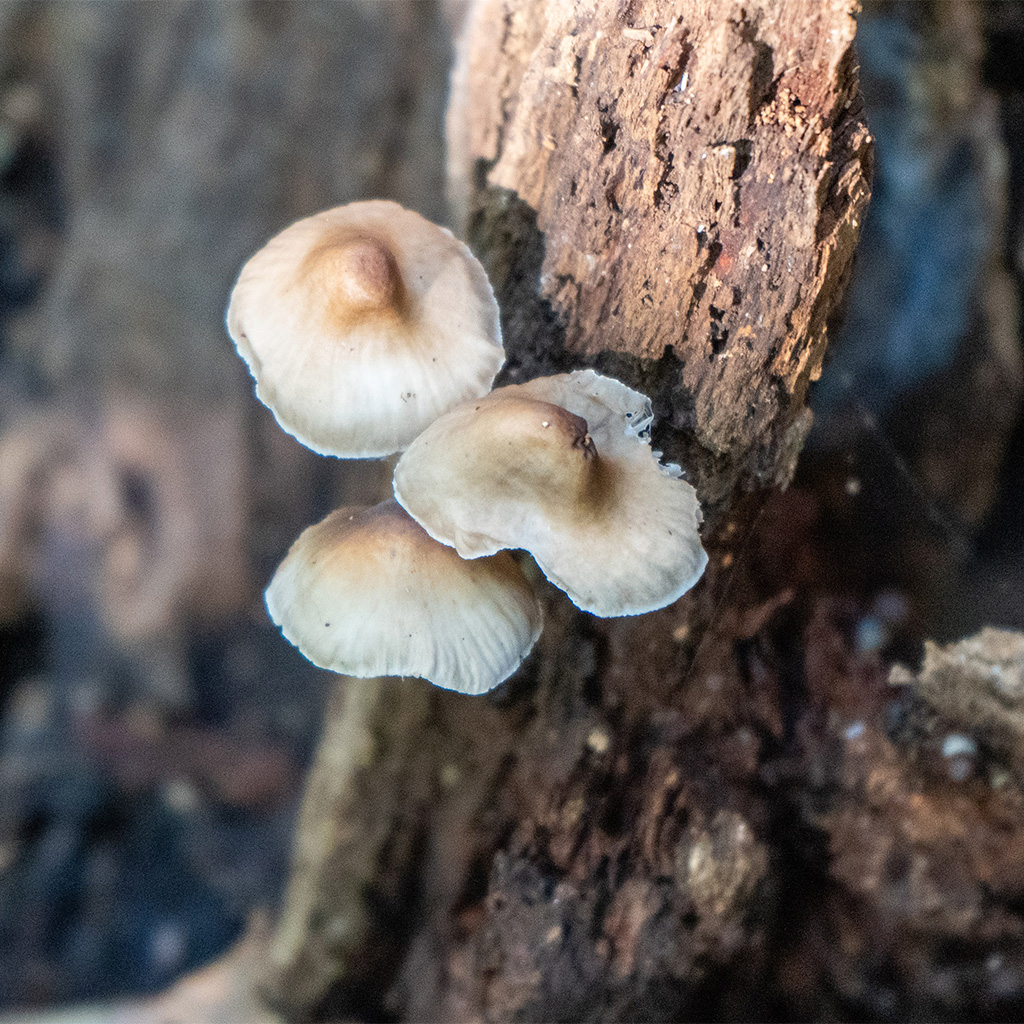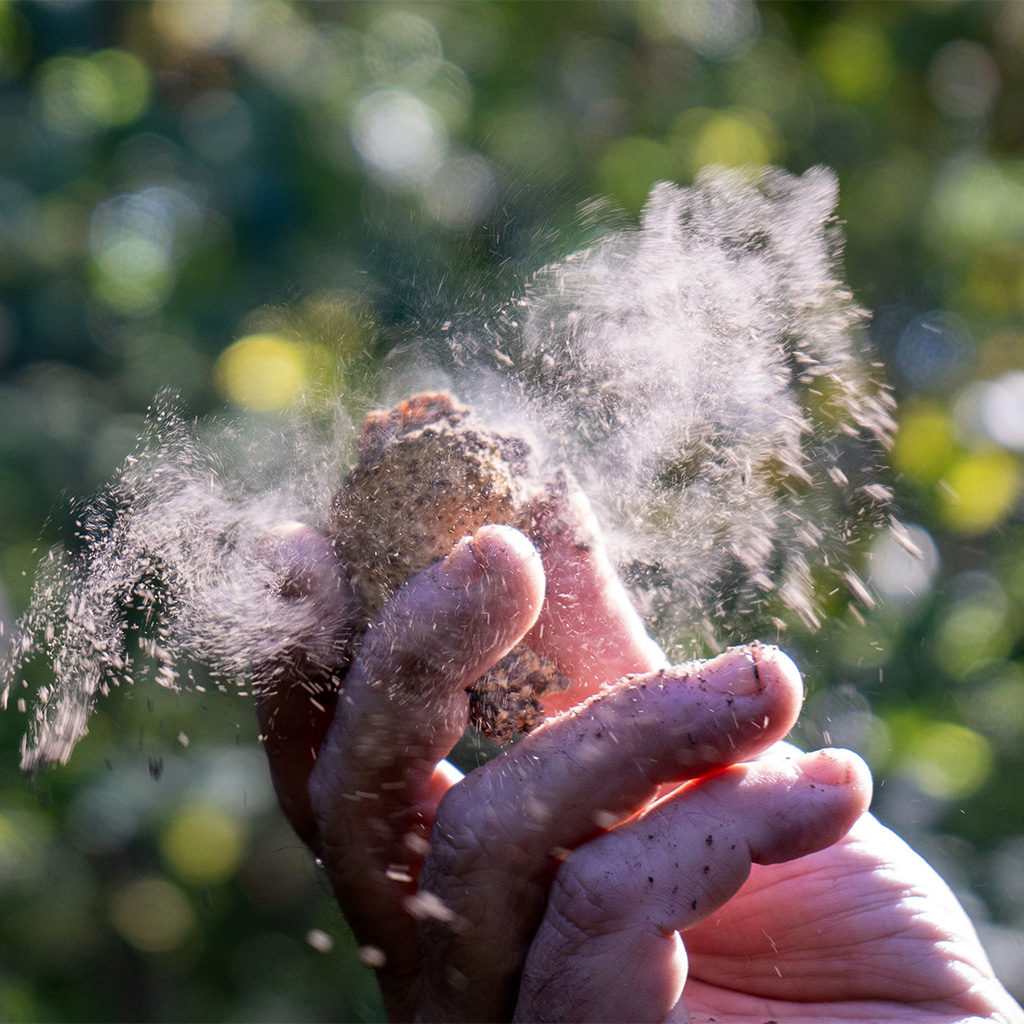Fungi is wild in its own way, and often weird; Fresh Pond alone has 367 documented kinds

These mushrooms near Fresh Pond get nutrients by breaking down the dead wood on which they grow. (Photo: Jeanine Farley)
I have written about many animals and even a few plants. Today, I am writing about something that is neither a plant nor an animal, but a fungus. (The word fungi has four pronunciations, so however you say it, you are probably correct.) Fungi are classified in a kingdom of their own, but DNA analysis has shown that they are more closely related to animals than to plants.
We all learned in school about how plants use energy from the sun to photosynthesize their own food. Animals cannot make their own food, so they eat plants (or plant-eating organisms) for energy. Fungi, like animals, eat other organisms. They are the decomposers of the world, breaking down and eating dead things such as rotting logs and leaves and turning them into soil.

Beneath the cap, many mushrooms have gills that release spores. (Photo: Jeanine Farley)
Fungi grow from microscopic spores. Mature fungi release millions of these spores, which are all around us every day – in your house, on your pants, in your hair. Most of these spores do nothing, but a few lucky ones land in a suitable place to grow. These spores germinate and send microscopic threads into wood (or leaves, or whatever the fungus wants to eat). The threads produce digestive enzymes and acids that break down the wood (or other material) into simple molecules. The fungi absorb these molecules through their cell walls.

Turkey tails on wood in Fresh Pond. (Photo: Jeanine Farley)
Over time, a fungus grows so many branching threads that they form an interwoven mat called a mycelium. If you dig through the ground or break up rotting wood, you might see a white fibrous mycelium, which can live for decades. People do not typically see this part of a fungus, though; what we most often see is the fruiting body, which sprouts out of wood or soil. Its purpose is to release spores so the process can start all over again.

Pigskin poison puffballs release spores into the air when squeezed. (Photo: Jeanine Farley)
You may have noticed that mushrooms sometimes seem to spring up overnight. This occurs because fruiting bodies grow in an unusual way. The hidden mycelium grows by the slow process of cell division, but the fruiting body grows by enlargement. The fungus pumps water into its cells, and almost overnight it can grow from the size of a pinhead to something much larger.
Fruiting bodies of fungi come in all shapes, sizes, and colors. I had the great good fortune to walk through Fresh Pond recently with noted mycologist, author and raconteur Lawrence Millman. He has documented 367 kinds of fungi at Fresh Pond alone. On our walk, he discovered a couple more that he had not yet documented. Most of the fungi we saw grew out of wood. Millman makes a habit of overturning logs to examine the fungi beneath.“Rolling logs is like a Christmas present,” he says. Of course, he always puts the logs back so the fungi can continue to develop.

Wolf’s milk slime contains a toothpastelike goo. (Photo: Jeanine Farley)
One of the first fungi we spotted was the common turkey tail (Trametes versicolor). Its mycelium lives inside rotting logs as a white network. When ready to reproduce, the turkey tail produces fruiting bodies outside dead wood. Turkey tails are so named because these fruiting bodies look like the outspread tail feathers of a male turkey. The underside of the “tails” produces the spores. Most fungi do not last very long, but turkey tails are an exception. Turkey tails break down dead wood and give it a bleached look called white rot.

Lemon drop cup fungi are bright lemon yellow. They grow in clusters and, despite their name, are not edible. (Photo: Jeanine Farley)
Another fungus we encountered was the pigskin poison puffball (Scleroderma citrinum). Its outer case, which has a football-like texture, holds the spores. As the spores mature, they become a powdery mass. If anything presses on the puffball, it ejects its spores into a puffy cloud carried off by the air. This fungus helps nourish forest trees. Its mycelia grow around tree roots. The fungus acquires nutrients and water from the soil, which the tree uses. The roots, in return, provide sugars that the fungus needs to grow. Many trees depend on fungal partners such as pigskin poison puffballs to stay healthy. Some invasive plants, including garlic mustard (Alliaria petiolata), have antifungal properties that suppress native tree growth by disrupting their beneficial fungi.

Gelatinous slime on a tree near Fresh Pond. (Photo: Jeanine Farley)
We then saw wolf’s milk slime (Lycogala epidendrum), also known as bubblegum or toothpaste slime. While not technically a fungus, slime behaves so similarly to fungi that it is often grouped with them. (Slime is not a plant, not an animal, and not a fungus. It is a soil-dwelling amoeba – a brainless, single-celled organism.) Most of the time, slime is too small to be seen, but it is there moving through soil and logs, engulfing and eating bacteria. When ready to reproduce, these unicellular individuals stop moving around and swarm together to form fruiting bodies, which we can see. These little pinkish balls grow in groups on rotting wood. If you pop a young pink one, it oozes a pinkish goo similar to toothpaste. As these balls mature, they become grayer and the “paste” becomes a powdery spore mass. The mature balls behave like puffballs when squeezed.

Milk-white toothed polypores grow on the bottom and sides of logs and branches of hardwood trees. The spore surface is mazelike, and eventually forms toothlike projections. (Photo: Jeanine Farley)
We saw many additional fungi on our walk, but there is not space enough here to do them justice. You might want to read Millman’s book Fascinating Fungi of New England to learn more about local fungi, often with intriguing names such as devil’s snuffbox, stinky squid, trumpet of death, dog’s nose, bleeding tooth or witch’s butter.
![]()
Reader photo

Jean Hill spotted this elk in her yard in Colorado Springs.
![]()
Have you taken photos of our urban wild things? Send your images to Cambridge Day, and we may use them as part of a future feature. Include the photographer’s name, date and the general location where the photo was taken as well as any other relevant information.
Jeanine Farley is an educational writer who has lived in the Boston area for more than 30 years. She enjoys taking photos of our urban wild things.


